Abstract
OBJECTIVES: This study evaluated the costs and cost-effectiveness of a school-based grade 6 universal vaccination program against hepatitis B. METHODS: We performed a descriptive cost study and cost-effectiveness analysis of British Columbia's vaccination program for 1994 and 1995. Since 1992, public health nurses have administered hepatitis B vaccine to grade 6 students in schools. We measured costs of vaccine, vaccine administration, and net program costs and used a validated Markov model to calculate the cost-effectiveness of the program. RESULTS: Vaccinating each student cost $44, $24 of which was the cost of vaccine administration. The net cost was $9 per person; considering productivity costs, net savings were $75 per person. Marginal cost per life year gained was $2100. Universal adolescent vaccination is also economically attractive in the United States but less attractive in regions with incidence rates below 3 cases per 100,000 per year. CONCLUSIONS: Hepatitis B vaccine can be delivered in North American schools at a reasonable cost. Adolescent vaccination is economically attractive in North American regions of high and average incidence rates. Our analysis supports vaccination in adolescents who remain at risk for hepatitis B virus infection.
Full text
PDF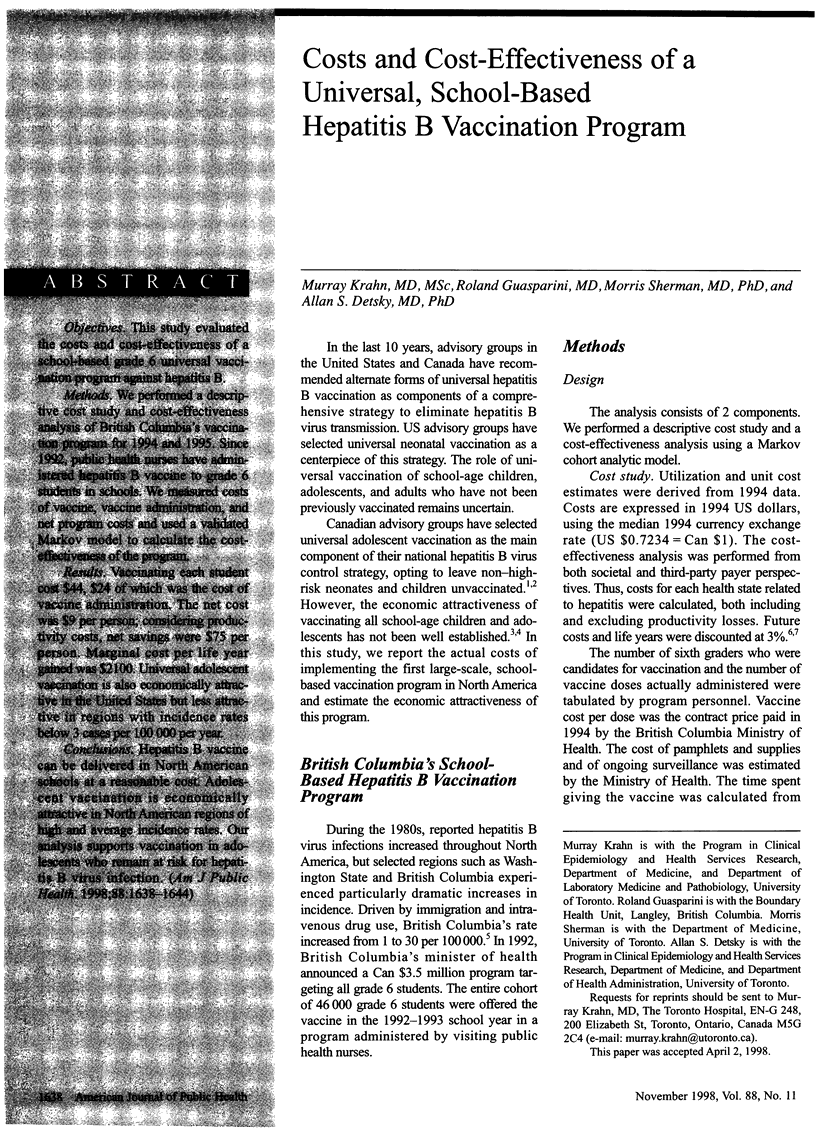
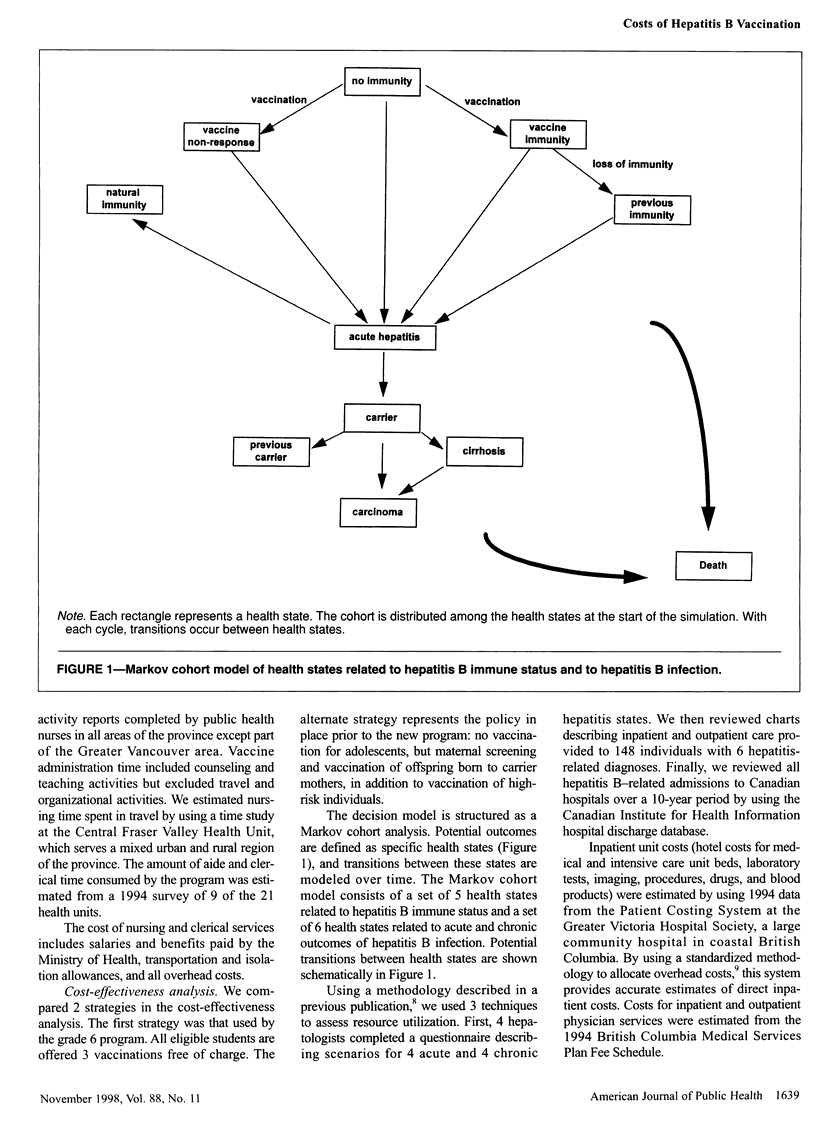
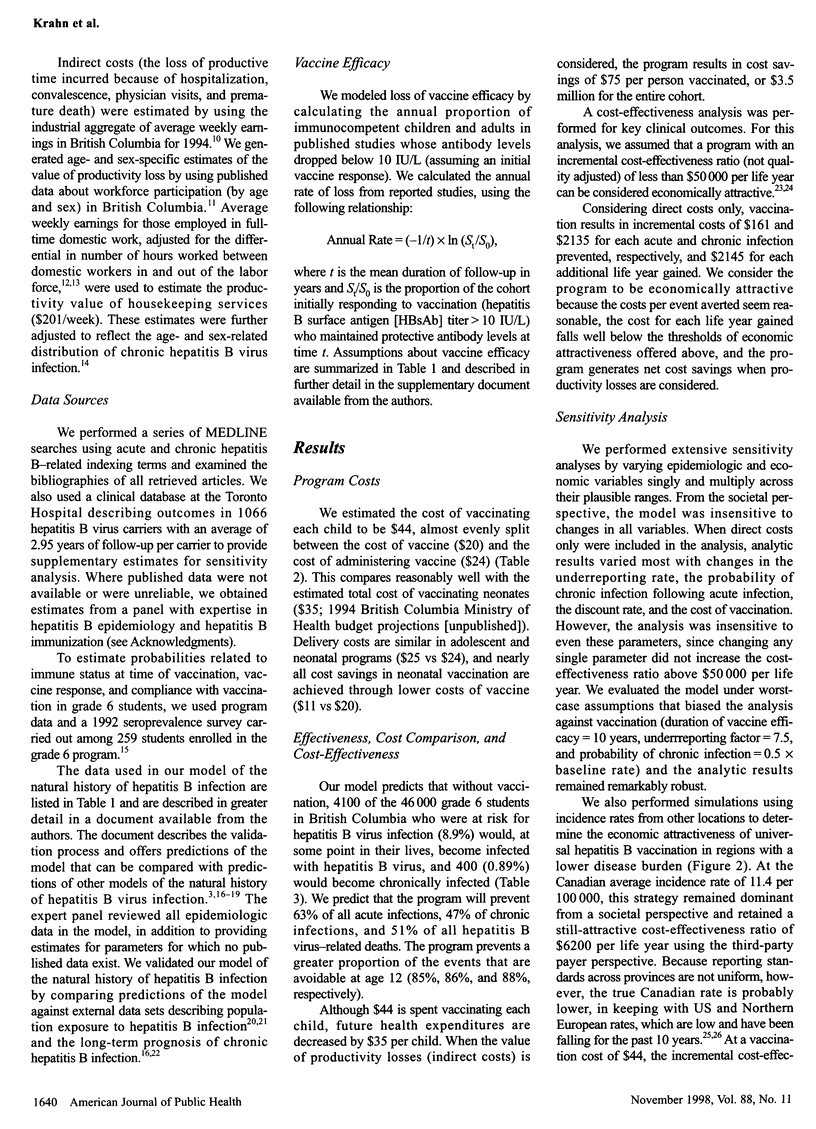

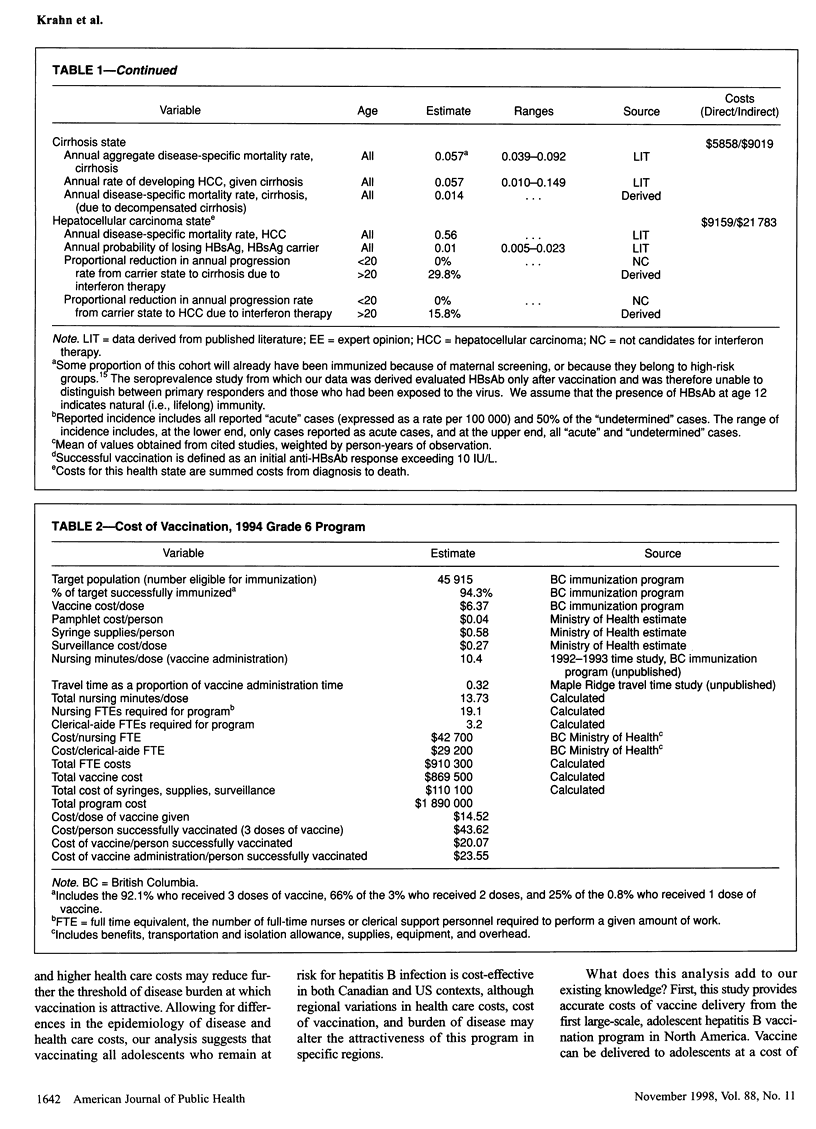
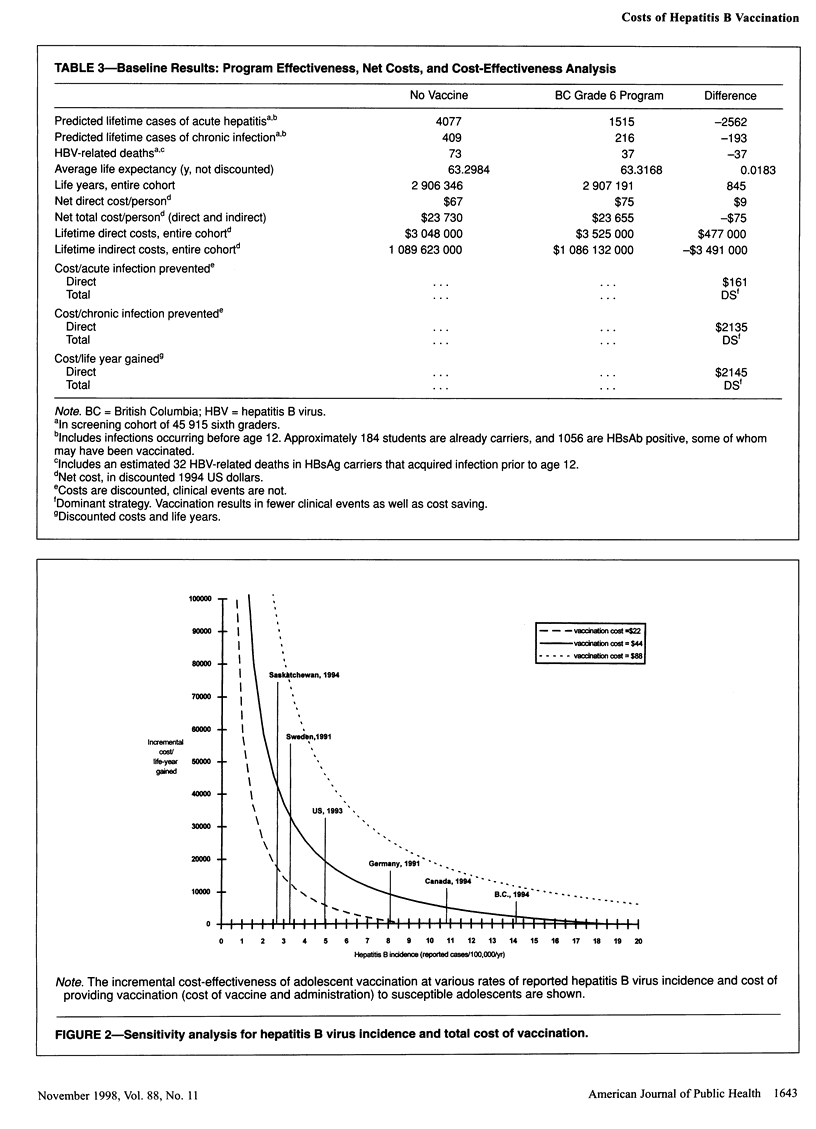
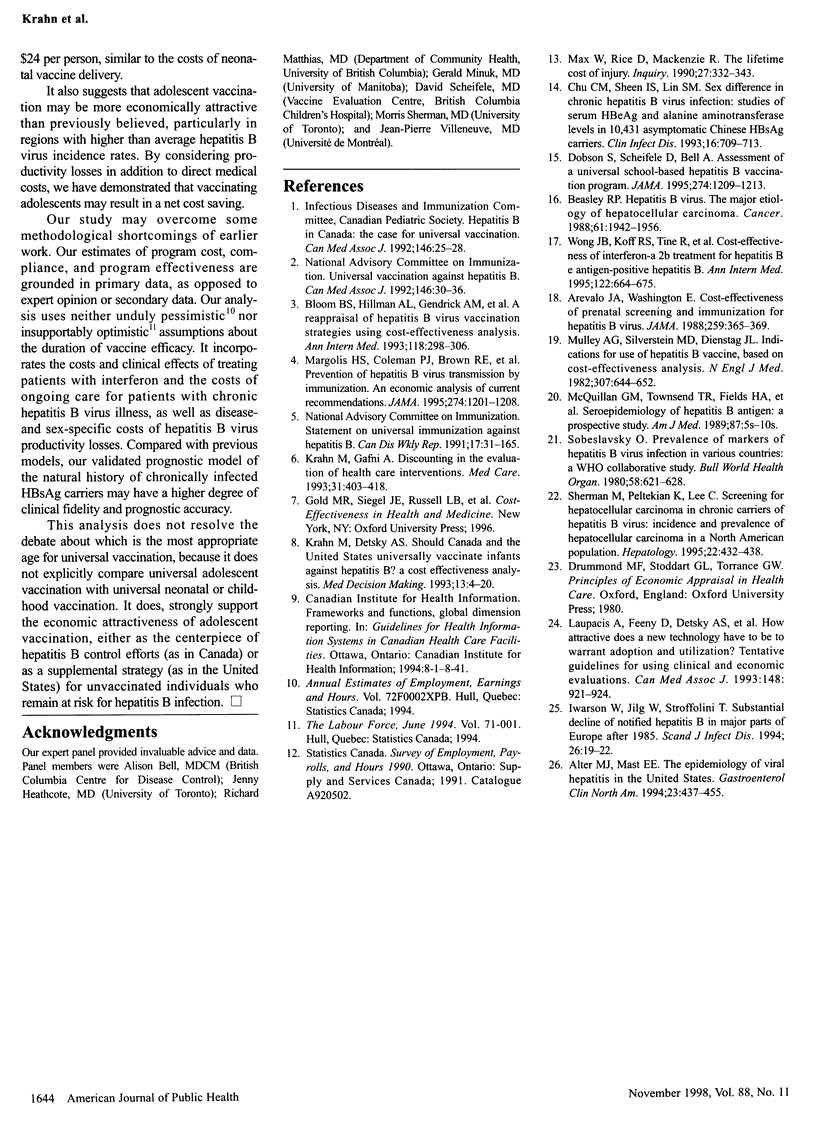
Selected References
These references are in PubMed. This may not be the complete list of references from this article.
- Alter M. J., Mast E. E. The epidemiology of viral hepatitis in the United States. Gastroenterol Clin North Am. 1994 Sep;23(3):437–455. [PubMed] [Google Scholar]
- Arevalo J. A., Washington A. E. Cost-effectiveness of prenatal screening and immunization for hepatitis B virus. JAMA. 1988 Jan 15;259(3):365–369. [PubMed] [Google Scholar]
- Beasley R. P. Hepatitis B virus. The major etiology of hepatocellular carcinoma. Cancer. 1988 May 15;61(10):1942–1956. doi: 10.1002/1097-0142(19880515)61:10<1942::aid-cncr2820611003>3.0.co;2-j. [DOI] [PubMed] [Google Scholar]
- Bloom B. S., Hillman A. L., Fendrick A. M., Schwartz J. S. A reappraisal of hepatitis B virus vaccination strategies using cost-effectiveness analysis. Ann Intern Med. 1993 Feb 15;118(4):298–306. doi: 10.7326/0003-4819-118-4-199302150-00009. [DOI] [PubMed] [Google Scholar]
- Chu C. M., Sheen I. S., Lin S. M., Liaw Y. F. Sex difference in chronic hepatitis B virus infection: studies of serum HBeAg and alanine aminotransferase levels in 10,431 asymptomatic Chinese HBsAg carriers. Clin Infect Dis. 1993 May;16(5):709–713. doi: 10.1093/clind/16.5.709. [DOI] [PubMed] [Google Scholar]
- Dobson S., Scheifele D., Bell A. Assessment of a universal, school-based hepatitis B vaccination program. JAMA. 1995 Oct 18;274(15):1209–1213. [PubMed] [Google Scholar]
- Iwarson S., Jilg W., Stroffolini T. Substantial decline of notified hepatitis B in major parts of Europe after 1985. Scand J Infect Dis. 1994;26(1):19–22. doi: 10.3109/00365549409008585. [DOI] [PubMed] [Google Scholar]
- Krahn M., Detsky A. S. Should Canada and the United States universally vaccinate infants against hepatitis B? A cost-effectiveness analysis. Med Decis Making. 1993 Jan-Mar;13(1):4–20. doi: 10.1177/0272989X9301300103. [DOI] [PubMed] [Google Scholar]
- Krahn M., Gafni A. Discounting in the economic evaluation of health care interventions. Med Care. 1993 May;31(5):403–418. doi: 10.1097/00005650-199305000-00003. [DOI] [PubMed] [Google Scholar]
- Margolis H. S., Coleman P. J., Brown R. E., Mast E. E., Sheingold S. H., Arevalo J. A. Prevention of hepatitis B virus transmission by immunization. An economic analysis of current recommendations. JAMA. 1995 Oct 18;274(15):1201–1208. [PubMed] [Google Scholar]
- Max W., Rice D. P., MacKenzie E. J. The lifetime cost of injury. Inquiry. 1990 Winter;27(4):332–343. [PubMed] [Google Scholar]
- McQuillan G. M., Townsend T. R., Fields H. A., Carroll M., Leahy M., Polk B. F. Seroepidemiology of hepatitis B virus infection in the United States. 1976 to 1980. Am J Med. 1989 Sep 4;87(3A):5S–10S. doi: 10.1016/0002-9343(89)90523-8. [DOI] [PubMed] [Google Scholar]
- Mulley A. G., Silverstein M. D., Dienstag J. L. Indications for use of hepatitis B vaccine, based on cost-effectiveness analysis. N Engl J Med. 1982 Sep 9;307(11):644–652. doi: 10.1056/NEJM198209093071103. [DOI] [PubMed] [Google Scholar]
- Naylor C. D., Williams J. I., Basinski A., Goel V. Technology assessment and cost-effectiveness analysis: misguided guidelines? CMAJ. 1993 Mar 15;148(6):921–924. [PMC free article] [PubMed] [Google Scholar]
- Sherman M., Peltekian K. M., Lee C. Screening for hepatocellular carcinoma in chronic carriers of hepatitis B virus: incidence and prevalence of hepatocellular carcinoma in a North American urban population. Hepatology. 1995 Aug;22(2):432–438. [PubMed] [Google Scholar]
- Sobeslavský O. Prevalence of markers of hepatitis B virus infection in various countries: a WHO collaborative study. Bull World Health Organ. 1980;58(4):621–628. [PMC free article] [PubMed] [Google Scholar]
- Wong J. B., Koff R. S., Tinè F., Pauker S. G. Cost-effectiveness of interferon-alpha 2b treatment for hepatitis B e antigen-positive chronic hepatitis B. Ann Intern Med. 1995 May 1;122(9):664–675. doi: 10.7326/0003-4819-122-9-199505010-00004. [DOI] [PubMed] [Google Scholar]


